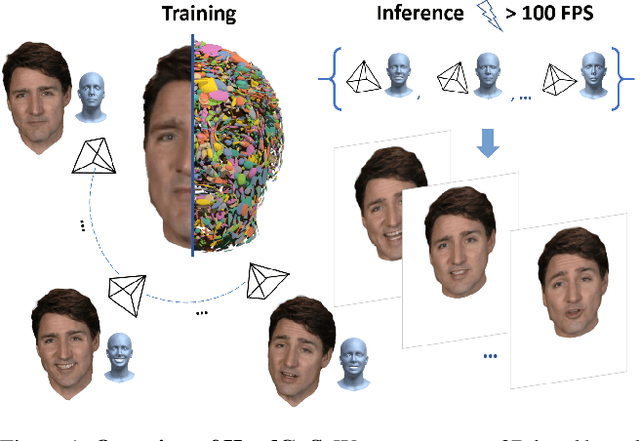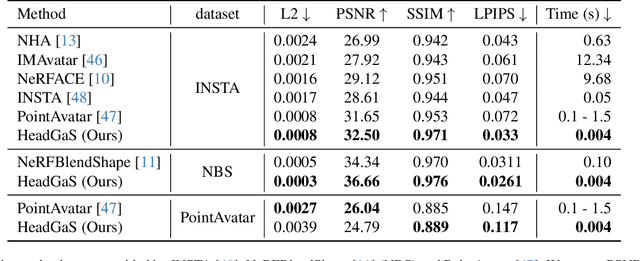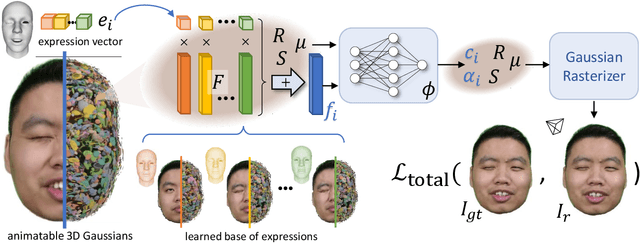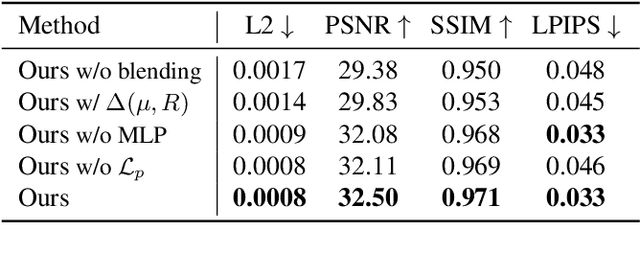Yinyu Nie
GarVerseLOD: High-Fidelity 3D Garment Reconstruction from a Single In-the-Wild Image using a Dataset with Levels of Details
Nov 05, 2024



Abstract:Neural implicit functions have brought impressive advances to the state-of-the-art of clothed human digitization from multiple or even single images. However, despite the progress, current arts still have difficulty generalizing to unseen images with complex cloth deformation and body poses. In this work, we present GarVerseLOD, a new dataset and framework that paves the way to achieving unprecedented robustness in high-fidelity 3D garment reconstruction from a single unconstrained image. Inspired by the recent success of large generative models, we believe that one key to addressing the generalization challenge lies in the quantity and quality of 3D garment data. Towards this end, GarVerseLOD collects 6,000 high-quality cloth models with fine-grained geometry details manually created by professional artists. In addition to the scale of training data, we observe that having disentangled granularities of geometry can play an important role in boosting the generalization capability and inference accuracy of the learned model. We hence craft GarVerseLOD as a hierarchical dataset with levels of details (LOD), spanning from detail-free stylized shape to pose-blended garment with pixel-aligned details. This allows us to make this highly under-constrained problem tractable by factorizing the inference into easier tasks, each narrowed down with smaller searching space. To ensure GarVerseLOD can generalize well to in-the-wild images, we propose a novel labeling paradigm based on conditional diffusion models to generate extensive paired images for each garment model with high photorealism. We evaluate our method on a massive amount of in-the-wild images. Experimental results demonstrate that GarVerseLOD can generate standalone garment pieces with significantly better quality than prior approaches. Project page: https://garverselod.github.io/
GauStudio: A Modular Framework for 3D Gaussian Splatting and Beyond
Mar 28, 2024Abstract:We present GauStudio, a novel modular framework for modeling 3D Gaussian Splatting (3DGS) to provide standardized, plug-and-play components for users to easily customize and implement a 3DGS pipeline. Supported by our framework, we propose a hybrid Gaussian representation with foreground and skyball background models. Experiments demonstrate this representation reduces artifacts in unbounded outdoor scenes and improves novel view synthesis. Finally, we propose Gaussian Splatting Surface Reconstruction (GauS), a novel render-then-fuse approach for high-fidelity mesh reconstruction from 3DGS inputs without fine-tuning. Overall, our GauStudio framework, hybrid representation, and GauS approach enhance 3DGS modeling and rendering capabilities, enabling higher-quality novel view synthesis and surface reconstruction.
Mesh2NeRF: Direct Mesh Supervision for Neural Radiance Field Representation and Generation
Mar 28, 2024Abstract:We present Mesh2NeRF, an approach to derive ground-truth radiance fields from textured meshes for 3D generation tasks. Many 3D generative approaches represent 3D scenes as radiance fields for training. Their ground-truth radiance fields are usually fitted from multi-view renderings from a large-scale synthetic 3D dataset, which often results in artifacts due to occlusions or under-fitting issues. In Mesh2NeRF, we propose an analytic solution to directly obtain ground-truth radiance fields from 3D meshes, characterizing the density field with an occupancy function featuring a defined surface thickness, and determining view-dependent color through a reflection function considering both the mesh and environment lighting. Mesh2NeRF extracts accurate radiance fields which provides direct supervision for training generative NeRFs and single scene representation. We validate the effectiveness of Mesh2NeRF across various tasks, achieving a noteworthy 3.12dB improvement in PSNR for view synthesis in single scene representation on the ABO dataset, a 0.69 PSNR enhancement in the single-view conditional generation of ShapeNet Cars, and notably improved mesh extraction from NeRF in the unconditional generation of Objaverse Mugs.
LASA: Instance Reconstruction from Real Scans using A Large-scale Aligned Shape Annotation Dataset
Dec 19, 2023Abstract:Instance shape reconstruction from a 3D scene involves recovering the full geometries of multiple objects at the semantic instance level. Many methods leverage data-driven learning due to the intricacies of scene complexity and significant indoor occlusions. Training these methods often requires a large-scale, high-quality dataset with aligned and paired shape annotations with real-world scans. Existing datasets are either synthetic or misaligned, restricting the performance of data-driven methods on real data. To this end, we introduce LASA, a Large-scale Aligned Shape Annotation Dataset comprising 10,412 high-quality CAD annotations aligned with 920 real-world scene scans from ArkitScenes, created manually by professional artists. On this top, we propose a novel Diffusion-based Cross-Modal Shape Reconstruction (DisCo) method. It is empowered by a hybrid feature aggregation design to fuse multi-modal inputs and recover high-fidelity object geometries. Besides, we present an Occupancy-Guided 3D Object Detection (OccGOD) method and demonstrate that our shape annotations provide scene occupancy clues that can further improve 3D object detection. Supported by LASA, extensive experiments show that our methods achieve state-of-the-art performance in both instance-level scene reconstruction and 3D object detection tasks.
HeadGaS: Real-Time Animatable Head Avatars via 3D Gaussian Splatting
Dec 05, 2023



Abstract:3D head animation has seen major quality and runtime improvements over the last few years, particularly empowered by the advances in differentiable rendering and neural radiance fields. Real-time rendering is a highly desirable goal for real-world applications. We propose HeadGaS, the first model to use 3D Gaussian Splats (3DGS) for 3D head reconstruction and animation. In this paper we introduce a hybrid model that extends the explicit representation from 3DGS with a base of learnable latent features, which can be linearly blended with low-dimensional parameters from parametric head models to obtain expression-dependent final color and opacity values. We demonstrate that HeadGaS delivers state-of-the-art results in real-time inference frame rates, which surpasses baselines by up to ~2dB, while accelerating rendering speed by over x10.
DPHMs: Diffusion Parametric Head Models for Depth-based Tracking
Dec 02, 2023Abstract:We introduce Diffusion Parametric Head Models (DPHMs), a generative model that enables robust volumetric head reconstruction and tracking from monocular depth sequences. While recent volumetric head models, such as NPHMs, can now excel in representing high-fidelity head geometries, tracking and reconstruction heads from real-world single-view depth sequences remains very challenging, as the fitting to partial and noisy observations is underconstrained. To tackle these challenges, we propose a latent diffusion-based prior to regularize volumetric head reconstruction and tracking. This prior-based regularizer effectively constrains the identity and expression codes to lie on the underlying latent manifold which represents plausible head shapes. To evaluate the effectiveness of the diffusion-based prior, we collect a dataset of monocular Kinect sequences consisting of various complex facial expression motions and rapid transitions. We compare our method to state-of-the-art tracking methods, and demonstrate improved head identity reconstruction as well as robust expression tracking.
3D Scene Diffusion Guidance using Scene Graphs
Aug 08, 2023Abstract:Guided synthesis of high-quality 3D scenes is a challenging task. Diffusion models have shown promise in generating diverse data, including 3D scenes. However, current methods rely directly on text embeddings for controlling the generation, limiting the incorporation of complex spatial relationships between objects. We propose a novel approach for 3D scene diffusion guidance using scene graphs. To leverage the relative spatial information the scene graphs provide, we make use of relational graph convolutional blocks within our denoising network. We show that our approach significantly improves the alignment between scene description and generated scene.
NerVE: Neural Volumetric Edges for Parametric Curve Extraction from Point Cloud
Mar 29, 2023Abstract:Extracting parametric edge curves from point clouds is a fundamental problem in 3D vision and geometry processing. Existing approaches mainly rely on keypoint detection, a challenging procedure that tends to generate noisy output, making the subsequent edge extraction error-prone. To address this issue, we propose to directly detect structured edges to circumvent the limitations of the previous point-wise methods. We achieve this goal by presenting NerVE, a novel neural volumetric edge representation that can be easily learned through a volumetric learning framework. NerVE can be seamlessly converted to a versatile piece-wise linear (PWL) curve representation, enabling a unified strategy for learning all types of free-form curves. Furthermore, as NerVE encodes rich structural information, we show that edge extraction based on NerVE can be reduced to a simple graph search problem. After converting NerVE to the PWL representation, parametric curves can be obtained via off-the-shelf spline fitting algorithms. We evaluate our method on the challenging ABC dataset. We show that a simple network based on NerVE can already outperform the previous state-of-the-art methods by a great margin. Project page: https://dongdu3.github.io/projects/2023/NerVE/.
DiffuScene: Scene Graph Denoising Diffusion Probabilistic Model for Generative Indoor Scene Synthesis
Mar 24, 2023Abstract:We present DiffuScene for indoor 3D scene synthesis based on a novel scene graph denoising diffusion probabilistic model, which generates 3D instance properties stored in a fully-connected scene graph and then retrieves the most similar object geometry for each graph node i.e. object instance which is characterized as a concatenation of different attributes, including location, size, orientation, semantic, and geometry features. Based on this scene graph, we designed a diffusion model to determine the placements and types of 3D instances. Our method can facilitate many downstream applications, including scene completion, scene arrangement, and text-conditioned scene synthesis. Experiments on the 3D-FRONT dataset show that our method can synthesize more physically plausible and diverse indoor scenes than state-of-the-art methods. Extensive ablation studies verify the effectiveness of our design choice in scene diffusion models.
Learning 3D Scene Priors with 2D Supervision
Nov 25, 2022Abstract:Holistic 3D scene understanding entails estimation of both layout configuration and object geometry in a 3D environment. Recent works have shown advances in 3D scene estimation from various input modalities (e.g., images, 3D scans), by leveraging 3D supervision (e.g., 3D bounding boxes or CAD models), for which collection at scale is expensive and often intractable. To address this shortcoming, we propose a new method to learn 3D scene priors of layout and shape without requiring any 3D ground truth. Instead, we rely on 2D supervision from multi-view RGB images. Our method represents a 3D scene as a latent vector, from which we can progressively decode to a sequence of objects characterized by their class categories, 3D bounding boxes, and meshes. With our trained autoregressive decoder representing the scene prior, our method facilitates many downstream applications, including scene synthesis, interpolation, and single-view reconstruction. Experiments on 3D-FRONT and ScanNet show that our method outperforms state of the art in single-view reconstruction, and achieves state-of-the-art results in scene synthesis against baselines which require for 3D supervision.
 Add to Chrome
Add to Chrome Add to Firefox
Add to Firefox Add to Edge
Add to Edge